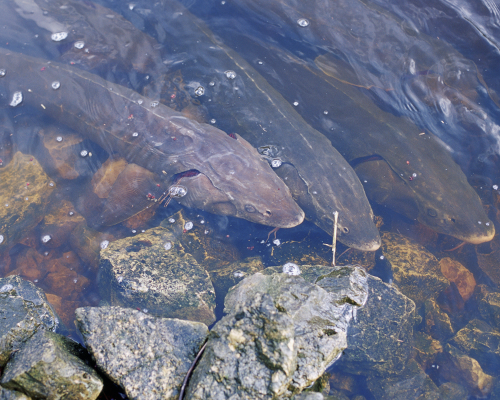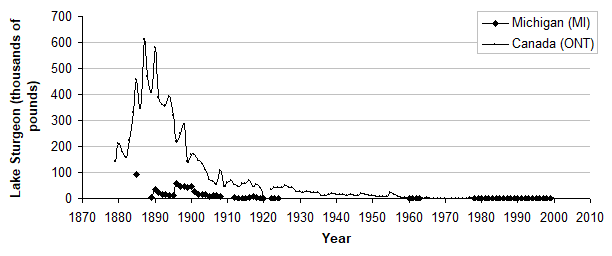Detroit River-Western Lake Erie Basin Indicator Project
Lake Sturgeon Population
Authors
Chiotti, J.A. and J.C. Boase, U.S. Fish and Wildlife Service, Trenton, Michigan, USABackground
The lake sturgeon (Acipenser fulvescens), a remnant of the dinosaur age, is considered a species of special concern by the U.S. Fish and Wildlife Service, a threatened species in North America by the American Fisheries Society, a globally rare species by the Nature Conservancy, and a threatened species in the State of Michigan (Figure 1). The lake sturgeon population in Michigan is estimated to be about one percent of its former abundance (Tody, 1974; Michigan Sea Grant, 2005). The Huron-Erie corridor was, at one time, one of the most productive waters for lake sturgeon in North America.

Figure 1. Lake sturgeon (Acipenser fulvescens) (Photo Credit: U.S. Fish and Wildlife Service).
In Lake Erie in the 1800s, sturgeon frequently caused heavy damage to fishing gear in nearshore waters. As a result, they were perceived as a nuisance and frequently killed upon capture to eradicate them (Hartman, 1973). In Lake Erie in the 1860s, lake sturgeon were destroyed in large numbers as bycatch of the gill net fishery (Regier and Hartman, 1973). Years following, the value of sturgeon increased as their eggs and smoked flesh became a delicacy. In 1890, a “caviar factory” was located in Algonac, Michigan on the St. Clair River (Harkness and Dymond, 1961). Populations quickly plummeted due to over harvesting, limited reproduction, and destruction of spawning habitats. Female lake sturgeon don’t reproduce until they are approximately 20 years old and even then they only spawn once every few years. Spawning sites also disappeared due to extensive dredging to create and maintain shipping channels in the Huron-Erie corridor. For example, the construction of the Livingstone Channel greatly decreased lake sturgeon and lake whitefish spawning habitats in Canadian waters, southeast of Stony Island.
Lake sturgeon are an indicator of ecosystem health because they are very sensitive to human disturbances, such as habitat destruction and pollution, as shown by their sharp decline in the late 1800s and early 1900s. They were present in the Huron-Erie corridor before European settlers inhabited the area. Lake sturgeon are considered a keystone species in the Detroit River ecosystem.
Status and Trends
In 1880, Lakes Huron and St. Clair produced over four million pounds of lake sturgeon (Hay-Chmielewski and Whelan, 1997). In 1890, Lake Erie produced over six hundred thousand pounds of lake sturgeon in Canadian waters. During the spawning period in June 1890, upwards of 4,000 adult lake sturgeon were caught in Lake St. Clair and the Detroit River on setlines and in pond-nets (Post, 1890; Harkness and Dymond, 1961; Figure 2). Today, there is no active commercial fishery for lake sturgeon in the Huron-Erie corridor, sport fishing harvest is now restricted in the St. Clair River and Lake St. Clair, and no sturgeon may be possessed by anglers from Michigan or Ontario waters of the Detroit River (Great Lake Fishery Commission, 2003; Michigan Department of Natural Resources, 2005; Ontario Ministry of Natural Resources, 2005).

Figure 2. Lake Erie commercial fish catch in Michigan and Ontario waters, 1879-2000; data source U.S. Fisheries Commission Report - Fishing industry for the Great Lakes Appendix 11 to the 1926 report by W. Koelz and in Baldwin et al., 2002.
From 1970s to 1999 no lake sturgeon spawning was reported in the Detroit River which, at one time, was one of the most productive sturgeon spawning grounds in the United States (Roseman et al., 2011). Then in 2001, lake sturgeon spawning was documented on a coal cinder pile near Zug Island in the Detroit River for the first time in over 20 years (Caswell et al., 2004). Based on research and monitoring, fishery biologists and managers concluded that lake sturgeon reproduction in the 2000s was now more limited by habitat than environmental quality.
In response, nine fish spawning reefs were constructed in the Detroit River in suitable areas that provided proper conditions and were in close proximity to requisite nursery habitats (Table 1). All were successful (Fischer et al., 2018). Each of these spawning reef projects were treated as experiments and included significant post-project assessment of effectiveness.
Table 1. Fish spawning reefs constructed in the Detroit River and post-project assessments of effectiveness (Hartig et al., in press).


Since 2006, the U.S. Fish and Wildlife Service has annually been conducting population assessments of lake sturgeon in the Detroit River. Over this time 523 lake sturgeon have been tagged and 34 have been recaptured. Based on these mark-and-recapture data, the estimated population size of lake sturgeon utilizing the Detroit River is 4,422 individuals with a 95% confidence interval of 2,758-6,087.
The Michigan Department of Natural Resources has established a rehabilitation goal of 750 sexually mature individuals to ensure self-sustaining populations (Hayes and Caroffino, 2012). Based on the current estimate of 4,422 individuals using the Detroit River, this would be considered a large, stable population meeting the goal of 750 sexually active individuals. However, this species still needs to be protected and fishery biologists and managers have built the nine reefs to help expand the lake sturgeon population. This will add resilience to the population, increase recruitment, and provide “egg donor” stock for other areas of the Great Lakes.
Next Steps and Research/Monitoring Needs
The long-term goal is to maintain a healthy, self-sustaining lake sturgeon population in the Detroit River. Short-term recommended actions include:
- enforcing conservative sturgeon harvest regulations throughout the Huron-Erie corridor;
- protecting sturgeon habitat in the Detroit River, including the nine reefs constructed since 2003;
- controlling pollution from combined sewer overflows and other sources within the watershed;
- undertaking regular sturgeon population assessments, including the use of telemetry, to decipher spawning sites; and
- establishing a Sturgeon Guarding Program, with active, progressive, public involvement.
References
- Baldwin, N. A., R. W. Saalfeld, M. R. Dochoda, H. J. Buettner, and R.L. Eshenroder. 2002. Commercial Fish Production in the Great Lakes 1867-2000. Great Lakes Fishery Commission, Ann Arbor, Michigan, USA.
- Bouckaert, E.K., Auer, N.A., Roseman, E.F., Boase, J., 2014. Verifying success of artificial spawning reefs in the St. Clair-Detroit River System for lake sturgeon (Acipenser fulvescens Rafinesque, 1817). Journal of Applied Ichthyology 30, 1393-1401.
- Briggs, A. S., Chiotti, J. A., Boase, J.C., 2015. 2014 native species report. U.S. Fish and Wildlife Service, Alpena Fish and Wildlife Conservation Office – Waterford Substation, Report No. 01. Waterford, Michigan, USA.
- Briggs, A. S., Kaulfersch, L.A., Chiotti, J.A., Johnson, J.L., Boase, J.C., 2016. 2015 native species report. U.S. Fish and Wildlife Service, Alpena Fish and Wildlife Conservation Office – Waterford Substation. Waterford, Michigan, USA.
- Caswell, N.M. 2003. Population Characteristics, Spawning Sites, and Movements of Lake Sturgeon (Acipenser fulvescens) in the Detroit River. Masters Thesis, Central Michigan University, Mount Pleasant, Michigan, USA.
- Caswell, N.M., Peterson, D.L., Manny, B.A., Kennedy, G.W., 2004. Spawning by lake sturgeon (Acipenser fulvescens) in the Detroit River. Journal of Applied Ichthyology 20, 1-6.
- Caswell, N.M., D.L. Peterson, B.A. Manny, and G.W. Kennedy. 2004. Spawning by lake sturgeon (Acipenser fulvescens) in the Detroit River. Journal of Applied Ichthyology 20:1-6.
- Fischer, J.L., Pritt, J.J., Roseman, E.F., Prichard, C.G., Craig, J.M., Kennedy, G.W., Manny, B.A.. 2018. Lake Sturgeon, Lake Whitefish, and Walleye Egg Deposition Patterns with Response to Fish Spawning Substrate Restoration in the St. Clair-Detroit River System. Transactions of the American Fisheries Society 147:79-93.
- Great Lakes Fishery Commission. 2003. Lake sturgeon in the Great Lakes; Lake sturgeon, the giant of the Great Lakes. Great Lake Fisheries Commission, Ann Arbor, Michigan, USA.
- Harkness, W. and J. Dymond 1961. The Lake Sturgeon. Ontario Dept. of Lands and Forests, Fish and Wildlife Branch, Ontario, Canada.
- Hartig, J.H., C. Sanders, R.J.H. Wyma, J.C. Boase, and E.F. Roseman (in press). Habitat rehabilitation in the Detroit River Area of Concern., Aquatic Ecosystem Health & Management.
- Hartman, W.L. 1973. Effects of Exploitation, Environmental Changes, and New Species on the Fish Habitats and Resources of Lake Erie. Great Lakes Fishery Commission, Technical Report Number 22. Ann Arbor, Michigan, USA.
- Hay-Chmielewski, E. and G. Whelan. 1997. Lake sturgeon rehabilitation strategy. Fish. Division, Michigan Department of Natural Resources, Special Report Number 18, Ann Arbor, Michigan, USA.
- Hayes, D.B., and D.C. Caroffino (Eds.). 2012. Michigan’s lake sturgeon rehabilitation strategy. Michigan Department of Natural Resources, Fisheries Special Report 62, Lansing, Michigan, USA.
- Holey, M, E. Baker, T. Thuemler, and R. Elliott. 2000. Research and assessment needs to restore lake sturgeon in the Great Lakes. Results of a workshop sponsored by the Great Lakes Fishery Trust, June 27-28, 2000, Muskegon, Michigan, USA.
- Koelz, W. 1926. Fishing Industry of the Great Lakes. Appendix XI to the Report of the U. S. Comissioner of Fisheries for 1925. United States Bureau of Fisheries Document Number 1001. Ann Arbor, Michigan, USA.
- Manny, B. A., Daley, B.A., Boase, J.C., Horne, A.N., Chiotti, J.A., 2014. Occurrence, habitat, and movements of the endangered northern madtom (Noturus stigmosus) in the Detroit River, 2003-2011. Journal of Great Lakes Research 40, 118-124.
- Manny, B.A., 2006. Monitoring element of the Belle Isle/Detroit River Sturgeon Habitat Restoration, Monitoring, and Education Project. Report to Michigan Sea Grant, Ann Arbor, Michigan, USA.
- Marranca, J.M., Welsh, A.B., Roseman, E.F., 2015. Genetic effects of habitat restoration in the Laurentian Great Lakes: an assessment of lake sturgeon origin and genetic diversity. Restoration Ecology 23, 455-464.
- Michigan Department of Natural Resources. 2005. Fishing Regulations, Lake Sturgeon. Lansing, Michigan, USA.
- Michigan Sea Grant. 2005. Lake Sturgeon Habitat Protection Background. Ann Arbor, Michigan, USA.
- OMNR (Ontario Ministry of Natural Resources). 2004. Regulatory options for managing the sport fishery of lake sturgeon in Ontario. Fisheries Section. Ontario Ministry of Natural Resources. Peterborough, Ontario, Canada.
- OMNR (Ontario Ministry of Natural Resources) 2005. Fishing regulations for the province of Ontario. Toronto, Ontario, Canada.
- Post, H. 1890. The sturgeon; some experiments in hatching. Trans. Amer. Fish. Soc. 19: 36-40.
- Prichard, C.G., Craig, J., Roseman, E.F., Fischer, J.L., Manny, B.A., Kennedy, G., 2017. Egg deposition by lithophilic spawning fishes in the St. Clair-Detroit River System, USA, 2005-2014. U.S. Geological Survey Scientific Investigations Report 2017–5003, Ann Arbor, Michigan, USA.
- Raymakers, C. and C. Hoover. 2002. Acipenseriformes: CITES implementation from Range States to consumer countries. Journal of Applied Ichthyology. 18: 629-638.
- Regier, H.A. and W.L. Hartman. 1973. Lake Erie’s Fish Community: 150 Years of Cultural Stresses. Science. 180(4092): 1248-1255.
- Roseman, E. Manny, B., Boase, J., Child, M., Kennedy, G., Craig, J., Soper, K., Drouin, R., 2011. Lake sturgeon response to a spawning reef constructed in the Detroit River. Journal of Applied Ichthyology. 27(2): 66-76.
- Schmidt, B.A., Wigren, P.L, Johnson, J.L., Fischer, L.A., Chiotti, J.A., Boase, J.C., 2017. 2016 Native Species Report. U.S. Fish and Wildlife Conservation Office-Waterford Substation, Waterford, Michigan, USA.
- Tody, W.H. 1974. Whitefish, sturgeon, and the early Michigan commercial fishery. Pages 45-60 in Michigan Fisheries Centennial Report 1873-1973. Michigan Department of Natural Resources, Lansing, Michigan, USA.